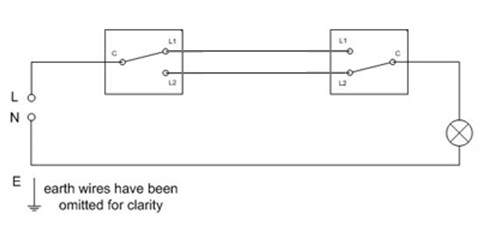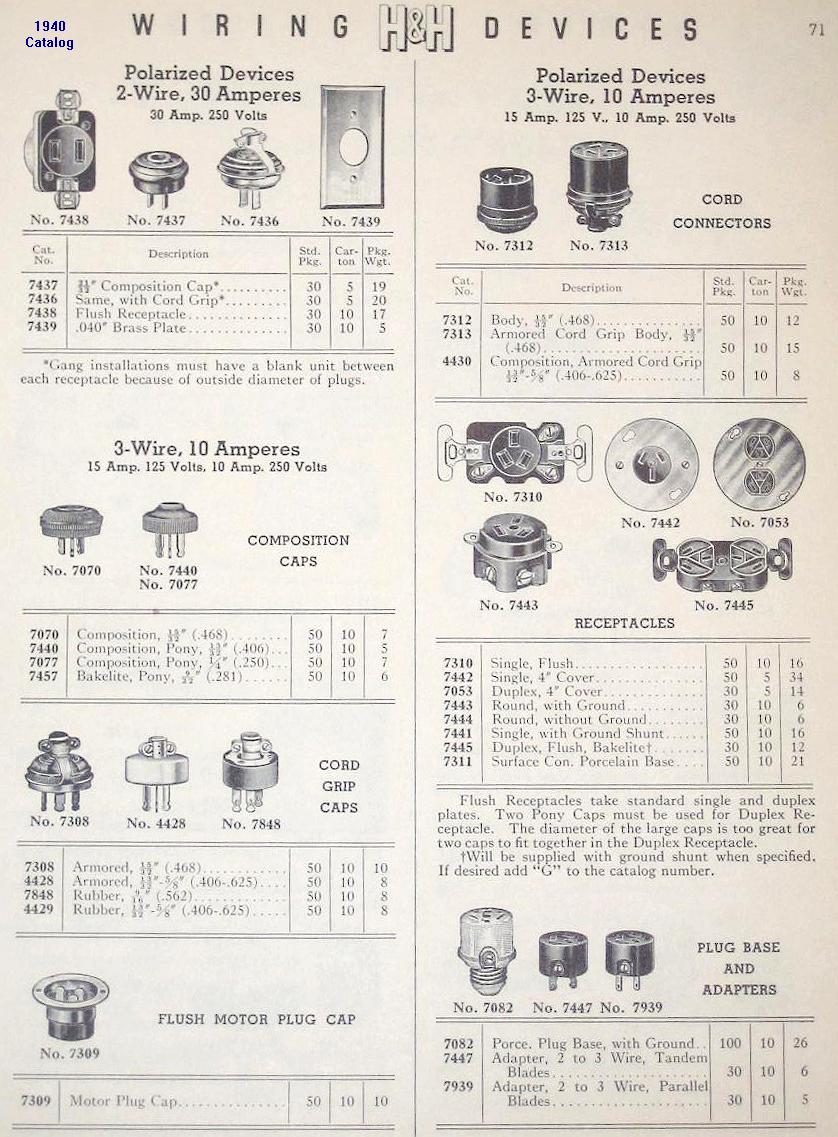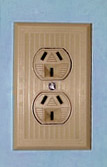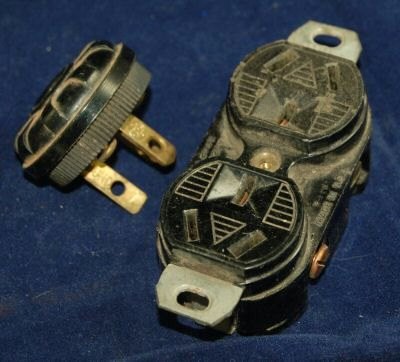Tech Talk
Forum home - Go back to Tech talk
|
Aussie style power point outlets in American electrical catalog from 1940
|
|
|
Return to top of page · Post #: 1 · Written at 7:49:23 AM on 25 May 2015.
|
|
|
|
Location: Oradell, US
Member since 2 April 2010 Member #: 643 Postcount: 835 |
|
|
|
|
Return to top of page · Post #: 2 · Written at 1:58:53 PM on 25 May 2015.
|
|
|
|
Location: Sydney, NSW
Member since 28 January 2011 Member #: 823 Postcount: 6887 |
|
Interesting find. I knew the design/patent was American, but I had not seen evidence of their production. |
|
|
Return to top of page · Post #: 3 · Written at 6:06:44 AM on 26 May 2015.
|
|
|
|
Location: Oradell, US
Member since 2 April 2010 Member #: 643 Postcount: 835 |
|
These were made, I have a few installed in my house, to provide my Aussie radios with 240VAC. The radios are perfectly happy with 60Hz. |
|
|
Return to top of page · Post #: 4 · Written at 4:14:12 PM on 26 May 2015.
|
|
|
|
Location: Silver City WI, US
Member since 10 May 2013 Member #: 1340 Postcount: 977 |
|
Earlier Aussie plugs also had prongs contour shaped like those in types 7440 to 7848! |
|
|
Return to top of page · Post #: 5 · Written at 9:46:36 PM on 6 June 2015.
|
|
|
|
Location: Canberra, ACT
Member since 23 August 2012 Member #: 1208 Postcount: 587 |
|
Interesting that this form was adopted as the standard for domestic 220vac in China - though in buildings older than 1950s other standards were in use. The chinese plugs had a slightly larger earth pin than the current Australian 240 5amp domestic plug - so they did not fit Australian sockets when I brought some back (1980s). That gives our "scream" plug a good chance of eventually being the most common world-wide, perhaps to the horror of others who consider themselves world standard-setters ! |
|
|
Return to top of page · Post #: 6 · Written at 10:17:27 PM on 6 June 2015.
|
|
|
|
Location: Sydney, NSW
Member since 28 January 2011 Member #: 823 Postcount: 6887 |
|
It wasn't originally a sad face/scream here until it was turned 180 degrees, so that the earth pin points south. |
|
|
Return to top of page · Post #: 7 · Written at 9:06:44 AM on 7 June 2015.
|
|
|
|
Location: Canberra, ACT
Member since 23 August 2012 Member #: 1208 Postcount: 587 |
|
Interesting point - I wonder what was the logic of that lateral orientation? 2-pin plugs most commonly have active and neutral in horizontal rather than vertical. It must be documented somewhere. |
|
|
Return to top of page · Post #: 8 · Written at 6:19:18 PM on 7 June 2015.
|
|
|
|
Location: Penrith, NSW
Member since 7 April 2012 Member #: 1128 Postcount: 403 |
|
Just an observation. ‾‾‾‾‾‾‾‾‾‾‾‾‾‾‾‾‾‾‾‾‾‾‾‾‾‾‾‾‾‾‾‾‾‾‾‾‾‾‾‾‾‾‾‾‾‾‾‾‾‾‾‾‾‾‾‾‾‾‾‾‾‾‾‾‾‾‾‾ I love the smell of ozone in the morning. |
|
|
Return to top of page · Post #: 9 · Written at 6:59:04 PM on 7 June 2015.
|
|
|
|
Administrator
Location: Naremburn, NSW
Member since 15 November 2005 Member #: 1 Postcount: 7564 |
|
HPM briefly made circuit breakers that were up-off down-on that plugged into Federal fuse blocks but these did not take off for long as soon after laws came in banning the installation of rewireable fuses, thus making the fuse blocks obsolete. ‾‾‾‾‾‾‾‾‾‾‾‾‾‾‾‾‾‾‾‾‾‾‾‾‾‾‾‾‾‾‾‾‾‾‾‾‾‾‾‾‾‾‾‾‾‾‾‾‾‾‾‾‾‾‾‾‾‾‾‾‾‾‾‾‾‾‾‾ A valve a day keeps the transistor away... |
|
|
Return to top of page · Post #: 10 · Written at 12:41:30 PM on 12 June 2015.
|
|
|
|
Location: Oradell, US
Member since 2 April 2010 Member #: 643 Postcount: 835 |
It's consistent, for the USA and Australia, if you think of it being: on is towards the North Pole, off towards the South Pole.  Just like when you drive east on an east-west road, use the side of the road closest to the Earth's equator. Just like when you drive east on an east-west road, use the side of the road closest to the Earth's equator.  For extra fun, if the light is controlled by two switches, then it is random at any one switch, depending on what the last user did.  The X in the circle symbol is the light bulb. The X in the circle symbol is the light bulb.American outlets don't have power switches on them. And I noticed on my holiday to Australia 25 or so years ago that Aussie outlets/powerpoints didn't have any mechanical interlocking mechanism to prevent me from plugging or unplugging something while the switch is left on. In the USA, the switch thus would be considered as pointless, from a safety viewpoint. We try to protect our idiots... 
|
|
|
Return to top of page · Post #: 11 · Written at 3:43:45 PM on 12 June 2015.
|
|
|
|
Location: Wangaratta, VIC
Member since 21 February 2009 Member #: 438 Postcount: 5606 |
|
In some cases unfortunately, idiot protection is actually rife here as well. They have introduced a plug with around 3/8" of sleeve adjacent the plug body on N & A to stop fingers & knives used as a crowbar from becoming alive. |
|
|
Return to top of page · Post #: 12 · Written at 8:51:03 AM on 13 June 2015.
|
|
|
|
Administrator
Location: Naremburn, NSW
Member since 15 November 2005 Member #: 1 Postcount: 7564 |
|
As Marc mentioned, two way switching is often installed in household hallways but is also commonplace in commercial installations. As indicated in WA2ISE's circuit diagram this involves connecting two standard mechanisms with a pair of straps (this is what the twin cable between the switches is known as in the trade). There is a second type of mechanism known as an intermediate switch and an unlimited number of these can be wired into the straps to cross over the connections and this provides extra switching capability in function rooms and long corridors. ‾‾‾‾‾‾‾‾‾‾‾‾‾‾‾‾‾‾‾‾‾‾‾‾‾‾‾‾‾‾‾‾‾‾‾‾‾‾‾‾‾‾‾‾‾‾‾‾‾‾‾‾‾‾‾‾‾‾‾‾‾‾‾‾‾‾‾‾ A valve a day keeps the transistor away... |
|
|
Return to top of page · Post #: 13 · Written at 11:28:41 AM on 13 June 2015.
|
|
|
|
Location: Wangaratta, VIC
Member since 21 February 2009 Member #: 438 Postcount: 5606 |
|
Delete |
|
|
Return to top of page · Post #: 14 · Written at 4:01:15 PM on 13 June 2015.
|
|
|
|
Administrator
Location: Naremburn, NSW
Member since 15 November 2005 Member #: 1 Postcount: 7564 |
|
I didn't see GTC's link until now. Those outlets were quite commonplace between the 1930s and 1960s. The one on the left emulates the US standard pattern. and their accessories are still made this way, to my knowledge. The socket mechanism in the first photo was either as pictured or vertical depending on the brand. HPM, Ring Grip, Wilco, Elmaco and Clipsal (plus a few others) made socket and switch mechanisms and plates for the standard pattern wall boxes. Some were plain, as pictured, and others had art-deco patterns. Black, brown and white were the only colours I know of. ‾‾‾‾‾‾‾‾‾‾‾‾‾‾‾‾‾‾‾‾‾‾‾‾‾‾‾‾‾‾‾‾‾‾‾‾‾‾‾‾‾‾‾‾‾‾‾‾‾‾‾‾‾‾‾‾‾‾‾‾‾‾‾‾‾‾‾‾ A valve a day keeps the transistor away... |
|
|
Return to top of page · Post #: 15 · Written at 4:06:42 PM on 13 June 2015.
|
|
|
|
Administrator
Location: Naremburn, NSW
Member since 15 November 2005 Member #: 1 Postcount: 7564 |
|
http://www.electrical-contractor.net/forums/ubbthreads.php/... ‾‾‾‾‾‾‾‾‾‾‾‾‾‾‾‾‾‾‾‾‾‾‾‾‾‾‾‾‾‾‾‾‾‾‾‾‾‾‾‾‾‾‾‾‾‾‾‾‾‾‾‾‾‾‾‾‾‾‾‾‾‾‾‾‾‾‾‾ A valve a day keeps the transistor away... |
|
|
You need to be a member to post comments on this forum.
|
|

Sign In

Vintage Radio and Television is proudly brought to you by an era where things were built with pride and made to last.
DISCLAIMER: Valve radios and televisions contain voltages that can deliver lethal shocks. You should not attempt to work on a valve radio or other electrical appliances unless you know exactly what you are doing and have gained some experience with electronics and working around high voltages. The owner, administrators and staff of Vintage Radio & Television will accept no liability for any damage, injury or loss of life that comes as a result of your use or mis-use of information on this website. Please read our Safety Warning before using this website.
WARNING: Under no circumstances should you ever apply power to a vintage radio, television or other electrical appliance you have acquired without first having it checked and serviced by an experienced person. Also, at no time should any appliance be connected to an electricity supply if the power cord is damaged. If in doubt, do not apply power.
Shintara - Keepin' It Real · VileSilencer - Maintain The Rage




